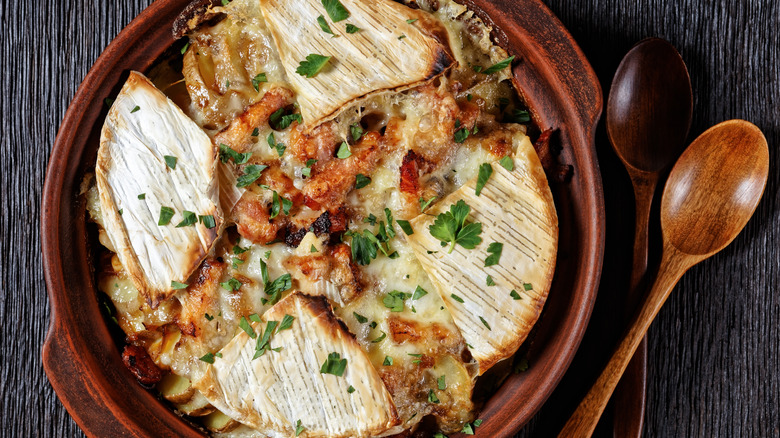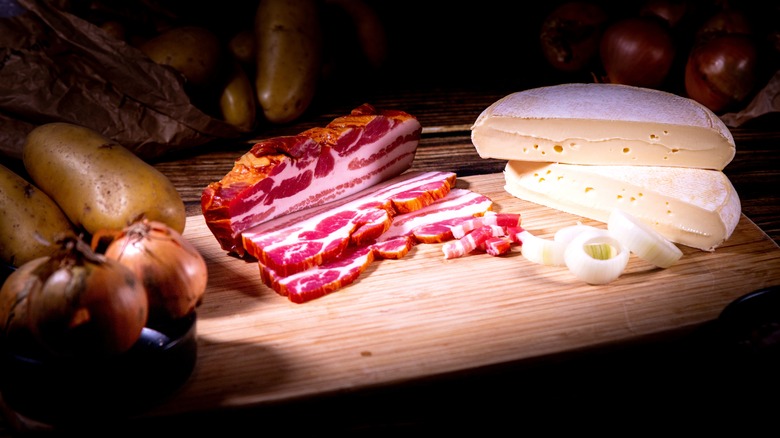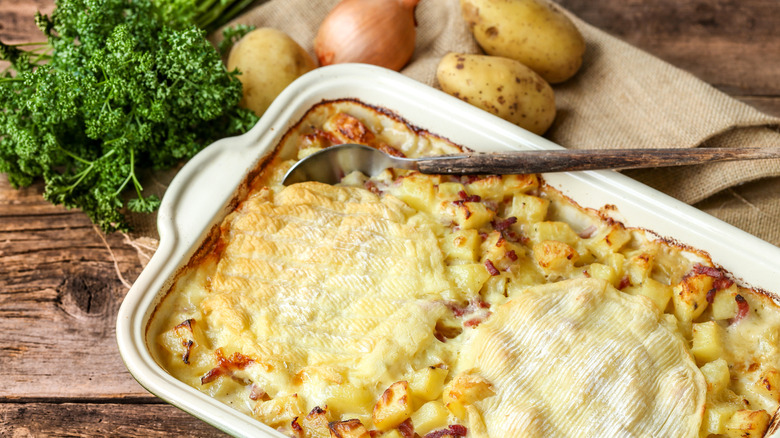Tartiflette Adds A French Twist To Cheesy Potatoes
Who can resist the delicious allure of cheese and potatoes? There's a good reason the combination exists across cultures, from Ecuadorian Llapingacho to disco fries and poutine, there is a high and low culture combination in every any cuisine. In France, you have longstanding regional recipes like Dauphinoise au gratin and the iconic style of mashed potatoes from Auvergne, pommes aligot. But did you know that a lesser-known, but equally cozy combination emerged in the 1980s?
Tartiflette is a Savoy dish that puts a new spin on péla, a traditional fried potato and onion gratin that has long been enjoyed in the region. It adds bacon and Reblochon, a creamy washed-rind cheese with subtle nutty notes that has been locally made since the 13th century, to the mix. Presumably developed as a marketing ploy by the Reblochon Interprofessional Trade Guild to sell their cheese, Savoyards have embraced this rich dish wholeheartedly. You'll find it on menus and at markets across the region during the colder months –- or, with a few simple modifications, you can make a delicious variation at home, too.
How this dish is traditionally made
While tartiflette can be called many things — luscious, decadent, and comforting all come to mind — one adjective you won't hear associated with the dish is complicated. Traditionally made using a short list of simple ingredients, these cheesy potatoes require minimal effort and will be on the table around an hour after you start preparing them.
First, sliced onions are cooked in vegetable oil until tender. Then starchy potatoes are peeled, cut, and added to the pan with smokey bacon lardons. Season the mix with salt and pepper to taste. Cook with the lid on until the potatoes are fork-tender, then transfer the mixture to a baking dish.
A wheel of Reblochon is cut in half horizontally to expose the creamy interior, then in half again. The four semicircles are laid on top of the potatoes, rine side up, and the dish is baked until gooey and golden brown. Tartiflette is best enjoyed alongside a hearty green salad dressed with a simple vinegarette and a glass of white wine, to balance the dish's rich flavors.
Preparation notes and substitutions for home chefs
Depending on where you live and the ingredients available in your area, you may have to adjust the original recipe. For example, in America, where the FDA has strict laws around the pasteurization of soft and semi-soft cheeses, it's illegal to sell authentic, Denomination of Origin-protected Reblochon cheese — it's made with raw milk. Although pasteurized versions do exist, like Préféré, unless you make your own or travel to the Alps, you won't be able to experience the real thing. This is also the reason you'll never eat 'real' brie in the US.
Thankfully, there are readily available cheeses that make great substitutions, like Camembert, Brie, Le Délice du Jura, or another creamy, bloomy rind cheese. Since these cheeses may not create the same melty sauce on their own, adding a bit of heavy cream or crème fraîche before baking will deliver comparable results.
Finally, while a Savoyard might object, many chefs find additions like garlic, shallot, nutmeg, or herbs to be great additions to the dish. Especially if you're substituting another cheese, consider additions like these that might complement its flavor and overall elevate the dish.



